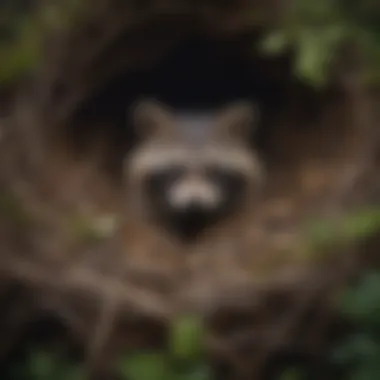Understanding Raccoon Nests in Trees: Ecology & Behavior


Intro
The humble raccoon is more than just a common sight in urban parks and wooded areas; it represents a species with complex behaviors and nesting habits. While many may not think much about where these creatures rest or raise their young, the construction of their nests in trees offers insight into their adaptability and survival strategies. Understanding raccoon nests provides valuable knowledge about not only these animals but also the ecosystems they inhabit.
Animal Species Profile
Prelude to the animal species
Raccoons, or Procyon lotor, are small to medium-sized mammals native to North America. Their distinct black and white facial markings, along with their ringed tails, make them easily recognizable. This species exhibits a range of behaviors that reflect their intelligence and adaptability to both wild and urban settings.
Physical characteristics and appearance
Adult raccoons typically weigh between eight to twenty pounds, and they measure about two to three feet in length, including their bushy tails. Their dense, grayish fur can vary, appearing almost silver under certain light conditions. Raccoons are known for their dexterous front paws, which enable them to manipulate objects effectively, contributing to their reputation as scavengers.
Natural habitat and distribution
Raccoons are highly adaptable creatures, found throughout North America, from urban environments to rural and wooded areas. They prefer habitats that provide access to water sources and abundant food, such as forests, marshes, and coastal areas. Their ability to thrive in urban settings has increased their population, making them a common sight in cities.
Behavior and social interactions
Raccoons are generally solitary, but they can exhibit social behaviors, especially when it comes to foraging for food or raising young. They are primarily nocturnal, using their acute sense of hearing and sight to navigate the night. Raccoons are also known to communicate through a series of vocalizations and body language, signaling their intentions or distress to other raccoons.
Nesting Habits in Trees
Raccoons construct nests in trees using leaves, twigs, and other materials they find in their environment. These nests play a vital role during birthing season, providing protection and insulation for the young. By observing these nesting behaviors, researchers have identified various factors influencing their choice of nesting sites, including the proximity to food sources and the safety from predators.
"Tree nests serve as a crucial refuge for juvenile raccoons, safeguarding them from environmental stressors and predation."
Understanding raccoon nesting habits is essential for conservation efforts as it reflects the broader health of their habitats. Raccoons, with their unique nesting strategies, not only adapt to various ecosystems but also highlight the challenges they face in urban areas.
Ecology of Tree Nests
Raccoon nests in trees contribute to the overall health of an ecosystem. These nests are not merely shelters for raccoons; they can shape the structure of forest ecosystems as well. When raccoons are present, they can affect the population dynamics of other species, whether through their predation or the seeds they scatter, which may germinate and grow into new plants.
Understanding the ecological significance of raccoon nests enhances our approach to wildlife conservation and helps balance the interactions between urban development and wildlife habitats. By recognizing the key role of raccoon nesting behavior, conservationists can advocate for more effective wildlife management strategies.
Overview of Raccoon Nesting Behavior
Raccoon nesting behavior is an intriguing area of study that provides insights into their ecological role and adaptability. Understanding how and where raccoons choose to nest elucidates their survival strategies. This section focuses on the key aspects of raccoon nesting, highlighting the significance of their preferences, behaviors, and the factors that influence their nesting habits.
Basic Nesting Habits
Raccoons exhibit specific nesting habits that vary according to their environment and individual needs. They typically seek secure locations where they can find shelter from predators and harsh weather conditions. Their nests are often located in sheltered areas, such as tree hollows, abandoned buildings, or dense shrubbery. The construction of these nests is a behavioral adaptation that aids in their survival. Moreover, raccoons are known to create multiple nests, allowing for better movement and flexibility in response to environmental changes. They will return to these nests frequently, particularly during breeding seasons.
Preference for Trees
Trees offer a unique set of advantages for raccoons when it comes to nesting. Their climbing abilities allow raccoons to access elevated nesting sites, which provide safety from ground-based predators. Furthermore, trees often have numerous cavities or branches that serve as viable nesting spots. The selection of a tree as a nesting site is influenced by several factors, including the tree's height, the structural integrity of the branches, and the surrounding landscape. Raccoons are particularly drawn to trees that are close to water sources, as these areas provide easy access to food and additional resources. This preference for trees underlines the significance of forests and wooded areas in supporting healthy raccoon populations.
Tree Selection Criteria
Understanding the criteria that raccoons use to select trees for nesting is crucial for comprehending their nesting behavior and overall habitat preferences. Raccoons are highly adaptive creatures, and their choice of trees for nests is influenced by several factors that ensure their survival and reproductive success. The suitability of a tree can significantly impact the raccoon's ability to raise young and avoid predators.
Height and Stability
The height of a chosen tree plays a significant role in the safety of the nest. Raccoons typically seek taller trees, as they provide elevation above potential ground-based threats. A higher nest offers a strategic advantage, allowing for a clearer view of the surroundings. Stability is equally important; a strong, sturdy tree is less likely to be damaged by wind or storms, ensuring the nest remains intact during harsh weather. When raccoons select a nesting tree, they often consider the tree's trunk thickness and root system, as these factors contribute to overall stability.


Proximity to Water Sources
Raccoons are often found near water sources, which play a critical part in their survival. Water availability influences food resources and can provide additional security against predators. Young raccoons rely on the nourishment their mothers gather from these areas, making proximity to rivers, streams, or lakes essential. Nesting near water can help raccoons easily access food options, such as fish or crustaceans, while also allowing them to maintain hydration for themselves and their young. This aspect of raccoon behavior highlights the interconnection between habitat elements and biological needs.
Surrounding Vegetation
The surrounding vegetation is another pivotal aspect of tree selection for nesting. Dense foliage provides cover for raccoons, enhancing their security from predators, such as coyotes or hawks. Vegetation can also offer supplementary materials for nest construction, allowing raccoons to gather leaves, twigs, and moss. Also, a diverse ecosystem with various plant species ensures a richer food supply and a habitat that supports both raccoons and their prey.
"The tree's environment is as vital as the tree itself for the raccoon nesting process."
Raccoons demonstrate a remarkable ability to assess their environment. The features of nearby plants help shape their nesting decisions, showcasing their adaptability as urban and rural habitats continue to change. Understanding these selection criteria is essential not just for raccoon advocacy, but also for broader wildlife management practices.
Construction of Tree Nests
The construction of tree nests is a significant aspect of raccoon behavior that merits thorough exploration. Understanding how and why raccoons build their nests in trees provides insight into their survival strategies and ecological roles. Nesting not only offers protection from predators but also acts as a safe haven for raising their young. The materials used for nest construction and the overall structural design reflect the adaptability of raccoons to their environment, demonstrating their resourcefulness in both wild and urban settings.
Materials Utilized
Raccoons are opportunistic creatures that utilize various materials when constructing their nests. They often choose components based on availability in their surroundings. The most common materials include:
- Twigs and branches: These are typically collected from the ground or the lower parts of trees. Twigs provide a solid framework for the nest.
- Leaves: Fresh leaves are particularly favored for lining the nest. They provide insulation and comfort for the young raccoons.
- Grass and moss: These soft materials are often used to cushion the interior of the nest, making it a cozy environment for the offspring.
- Human debris: In urban areas, raccoons can integrate discarded items such as paper, plastic, or even fabric into their nests. This adaptability speaks to their ability to thrive in various environments, including those heavily influenced by human activity.
The careful selection of these materials plays a vital role in maintaining the nest's integrity and ensuring the safety of its inhabitants. Each component serves a specific purpose, enhancing the adaptability of raccoons to diverse habitats.
Nest Structure and Design
The structure and design of raccoon nests also deserve attention as they showcase architectural ingenuity relative to their needs. Here are some key features:
- Location: Raccoon nests are often built in high, inaccessible parts of trees, which helps protect them from ground predators. The height also provides a broader view of their surroundings.
- Shape: Most nests take on a bowl-like shape, created by weaving twigs and larger pieces of foliage. This shape facilitates rain runoff, preventing water accumulation that may compromise the nest's stability.
- Size: The size of the nest can vary considerably. A typical nest may accommodate one or two adult raccoons and their young, but larger nests might be utilized when multiple females share a raising area, especially during communal rearing of offspring.
- Ventilation: Good ventilation is integral to a raccoon's nest. Openings in the construction allow for airflow, helping to maintain a suitable internal environment to shield against heat and humidity.
The design of raccoon nests illustrates their adaptability and highlights the importance of their environment in shaping their nesting strategies. These nests not only serve as protective structures but also reflect the harmonious relationship between raccoons and their habitats.
"Understanding how raccoons construct their nests provides deeper insights into their adaptability and roles within ecosystems."
Research into raccoon nesting behaviors can aid in fostering effective wildlife management practices, especially in urban settings where human-wildlife interactions are frequent.
Behavioral Aspects of Nesting
Understanding the behavioral aspects of raccoon nesting is vital for comprehending their survival strategies and ecological adaptations. Nests serve not only as shelters but also as places for raising young and storing food. This section examines two key components: nesting cycles and parental roles, helping us grasp the significance of raccoon nests in their lifecycle and behavior.
Nesting Cycles
Raccoon nesting cycles are closely tied to their reproductive patterns. Female raccoons typically enter estrus between late winter and early spring. This is crucial as it determines the timing of their nesting activities. After mating, a female raccoon seeks a suitable tree for her nest.
Raccoons generally give birth to litters of 3-7 kits after a gestation period of about 63 days. The nesting cycle can be broken down into three primary phases:
- Preparation: Females will often begin nest construction before the kits are born. This involves collecting materials such as leaves, twigs, and even human-made items like plastic and fabric.
- Gestation and Birth: During the gestation phase, the mother spends a lot of time in the nest, conserving energy and reducing stress. After the birthing process, she remains close to the nest to care for her young.
- Weaning and Independence: Kits are usually weaned at about 8-10 weeks. After this, the mother teaches them foraging skills, gradually leading them out of the nest. Understanding these cycles is key to ensuring the welfare of raccoons, especially in areas where human activity threatens their natural habitats.
Parental Roles
Parental involvement in raccoon nesting behavior is largely maternal. The mother takes on the primary responsibility of rearing the kits. In the wild, this can be challenging due to predators and environmental pressures. Here are several points regarding the maternal role:
- Nurturing: The mother raccoon is very protective. She will defend her nest vigorously against threats.
- Feeding: In the early stages, she nurses her young, providing them with essential nutrients. As they grow, she begins to teach them how to find food.
- Teaching: The mother plays a critical role in teaching her kits about foraging and the skills necessary for survival. This education period is crucial in ensuring that the young raccoons can thrive once they leave the nest.
"Raccoons exhibit remarkable adaptability, which is essential for their survival in changing environments."


In summary, examining the behavioral aspects of nesting reveals not only the intricate nesting cycles of raccoons but also the vital role mothers play in nurturing and teaching their young. This knowledge is essential for conservation efforts and understanding their ecological impact.
Raccoons symbolize the resilience of wildlife and the importance of preserving their natural habitats.
Impact of Environmental Conditions
Understanding the impact of environmental conditions on raccoon nests is crucial for comprehending their nesting behavior. Raccoons are adaptive animals, but their survival and nesting success can be influenced by various factors, such as seasonal changes and weather events.
Seasonal Variations
Seasonal changes play a significant role in raccoon nesting patterns. In temperate regions, the four seasons dictate food availability, which influences the nesting cycle. During spring and summer, raccoons tend to be more active as natural food sources, including fruits and insects, are abundant. These conditions allow them to gather materials and build nests more effectively.
In contrast, autumn marks a period of preparation. Raccoons often seek to store food or relocate to more sheltered spots in anticipation of the harsher winter months. During winter, nests may not be as actively used, as raccoons often reduce their activity levels significantly. The nest becomes a refuge to escape cold temperatures. This seasonal rhythm affects both the nesting location and the structure of the nests.
Moreover, the reproductive cycle of raccoons aligns with these seasonal changes. Female raccoons, known for their maternal instincts, tend to give birth in late spring when resources are plentiful. This timing ensures that their offspring have the best chance for survival, with warmer weather providing a safer environment for the young.
Weather Influences
Weather events can also impact raccoon nesting behavior significantly. Heavy rains, strong winds, and snow can result in the destruction of nests or their materials. Raccoons are known to be resourceful. They often adapt by relocating to sturdier structures or choosing different trees to build their nests.
Extreme precipitation can lead to flooding, which further complicates their habitat. This situation may force raccoons to abandon their nests to find higher ground. As a result, weather conditions can dictate not only where raccoons choose to nest but also how often they may need to relocate.
Several factors come into play regarding weather influences:
- Nesting materials: Raccoons prefer nests built from leaves, branches, and other debris. Heavy rain or storms can wash away these materials, prompting a search for new nesting sites.
- Temperature extremes: While raccoons can tolerate a certain range of temperatures, extreme cold or heat can drive their nesting behavior into areas that offer better shelter or temperature regulation.
- Natural disasters: Events such as hurricanes or wildfires can completely disrupt local ecosystems, forcing raccoons to adapt quickly to survive.
In summary, understanding how seasonal variations and weather influences affect raccoon nests gives insights into their behavioral adaptations. Recognizing these factors is vital for wildlife management and conservation initiatives.
Urban Environments and Raccoon Nests
Urban environments present unique challenges and opportunities for raccoons, significantly influencing their nesting behaviors. As cities expand, they alter the natural habitats raccoons once frequented. Thus, understanding how raccoons adapt to urban settings is crucial for wildlife management and conservation efforts. This section delves into the adaptability of these animals in urban landscapes, alongside the interactions they have with humans.
Adaptation to Urban Settings
Raccoons are highly adaptable creatures. Their intelligence and resourcefulness make them capable of thriving in urban areas. Unlike many wildlife species that may struggle to find food and shelter in cities, raccoons exploit human environments. They utilize available urban structures, such as attics or abandoned buildings, for nesting. This flexibility in choosing nest sites allows them to avoid the dangers present in more natural habitats.
In urban settings, raccoons often find ample food, primarily from human waste, pet food, and unsecured garbage bins. This leads to a higher population density of raccoons in cities, as they can sustain themselves with less effort than in the wild.
Furthermore, they may prefer nesting in trees that are close to human habitation, allowing for easy access to food while still providing a degree of safety. The sync between their natural instincts and the abundance of resources in urban environments leads to an increase in their overall population.
Human-Raccoon Interactions
The presence of raccoons in urban areas often leads to various interactions with humans. While some individuals view raccoons as charming urban wildlife, others may see them as pests. This duality creates complex dynamics that are essential to navigate.
Human-raccoon interactions can be both beneficial and detrimental:
- Benefits: Raccoons contribute to urban ecosystems by helping control insect populations and aiding in seed dispersion. Their foraging habits can enrich the ecological balance within city parks and green spaces.
- Challenges: When raccoons invade homes or businesses, they can cause damage. They may tear apart roofing material or make nests in inappropriate spaces. This interference can lead to conflicts, prompting homeowners to seek pest control.
To mitigate the negative aspects of these interactions, education is vital. People should be encouraged to secure their rubbish and avoid leaving pet food outside. Understanding raccoon behaviors can provide valuable insights into coexisting peacefully with these animals.
"Adapting to urban environments demonstrates the remarkable resilience of raccoons. Their survival skills are a testament to their evolutionary success, but they also highlight our responsibility in wildlife management."
Conservation Implications
Understanding the conservation implications of raccoon nests in trees is crucial for wildlife enthusiasts and anyone interested in maintaining biodiversity. Raccoons, despite being considered pests in some urban areas, play significant roles in various ecosystems. Their nesting behaviors directly impact not only their survival but also that of other species in their habitats.


Role of Raccoons in Ecosystems
Raccoons serve as important ecological actors within their environments. They are omnivores, consuming a wide range of foods, from fruits to small mammals. This feeding behavior helps in seed dispersal, promoting plant diversity. Moreover, raccoons can influence the populations of their prey, thus contributing to the natural balance.
Through their natural foraging habits, raccoons inadvertently support the growth of healthier forests and grasslands. Their presence can signal a well-functioning ecosystem. Fostering raccoon populations in appropriate habitats can ensure that other wildlife thrives as well.
Conservation Challenges
Despite their ecological importance, several challenges face raccoon conservation. Urbanization has led to habitat loss, diminishing the natural environments they rely on for nesting and foraging. In addition, interactions with humans can lead to conflicts, such as property damage or disease transmission. These interactions often result in raccoons being viewed negatively, leading to increased culling or removal efforts.
Furthermore, climate change poses a threat to raccoon habitats. Changes in temperature and precipitation patterns can affect food availability and nesting sites. To combat these challenges, conservation efforts must focus on habitat restoration and education. Understanding the role of raccoons in ecosystems promotes a more nuanced view of their presence and helps foster coexistence.
Recognizing raccoons' ecological contributions facilitates better conservation strategies that benefit them and the environment.
Future Research Directions
The exploration of raccoon nesting behaviors in trees is a growing field of interest, particularly as it pertains to understanding their ecological roles and survival strategies. Future research directions are crucial for advancing knowledge in this area, particularly in the context of changing environments and human encroachment on wildlife habitats. By focusing on specific elements such as innovative tracking methods and longitudinal studies, researchers can gain deeper insights into these fascinating creatures.
Innovative Tracking Methods
One of the significant advancements in raccoon research lies in the development of innovative tracking methods. Traditional tracking techniques, such as radio collaring, have provided valuable information about raccoon movement patterns. However, these methods can be invasive and may not capture the full scope of their behaviors in natural settings.
Recent technological advancements, including the use of GPS collars and camera traps, have shown promise. These tools allow researchers to gather real-time data on raccoon activities, nest occupancy rates, and interactions with their environment.
- Benefits of GPS Tracking:
- Advantages of Camera Traps:
- Provides real-time location data.
- Minimizes animal stress associated with traditional methods.
- Captures behavioral data without disturbing the animals.
- Allows for a non-invasive study of social structures.
Integrating these innovative methods can yield comprehensive data that will enhance understanding of raccoon nesting habits and their adaptation to different ecological settings.
Longitudinal Studies on Nesting Behavior
Longitudinal studies are essential for examining changes in raccoon nesting behavior over time. These studies track raccoons across seasons and years, providing insights into how various factors, such as climate change and urbanization, influence their nesting choices.
- Key Areas to Focus On:
- Nesting Site Fidelity: Understanding whether raccoons return to the same nesting sites year after year can inform conservation strategies.
- Adaptation Strategies: Assessing how raccoons modify nesting behaviors in response to disturbances is crucial in evolving urban landscapes.
These long-term observations allow researchers to identify trends that may not be evident in short-term studies.
"Longitudinal research will be imperative to predict how raccoons might adapt in a rapidly changing world, creating a foundation for effective wildlife management strategies."
Summary and Culminations
Raccoon nests in trees serve a critical role in the survival and reproductive success of these animals. Understanding their nesting behavior leads to insights on their ecological importance. This section synthesizes the key findings and implications of the research discussed throughout the article, providing a comprehensive perspective on raccoon nesting habits and their broader environmental context.
Key Findings
The research reveals several significant aspects of raccoon nesting behavior.
- Raccoons prefer tree nests because of their height and protection from predators. The selection varies based on geographical regions and available resources.
- The nests are often constructed from materials like leaves, twigs, and other natural debris, showcasing a significant level of adaptability and resource utilization.
- Environmental factors such as weather conditions and seasonal changes impact the timing of nesting and parental roles.
- Urban habitats present unique challenges and opportunities for raccoon nesting, resulting in behavior adaptations.
These findings contribute to the understanding of not only raccoon ecology but also the complex relationships they maintain with their habitats.
Implications for Wildlife Management
The insights gained from studying raccoon nesting behaviors can inform wildlife management strategies.
- Recognizing the ecological roles of raccoons helps to maintain balanced ecosystems, as they contribute to controlling pest populations and seed dispersal.
- Urban areas must adopt management practices that consider raccoon nesting and behaviors, minimizing human-wildlife conflict. Understanding their nesting preferences facilitates educated decision-making in urban planning and conservation efforts.
- Research into raccoon responses to urbanization can guide conservation policies to protect these important mammals, helping ensure their populations remain stable in the face of habitat loss and fragmentation.
Understanding and preserving raccoon nest patterns will enhance wildlife strategies, leading to sustainable ecosystems where raccoons and humans can coexist.







